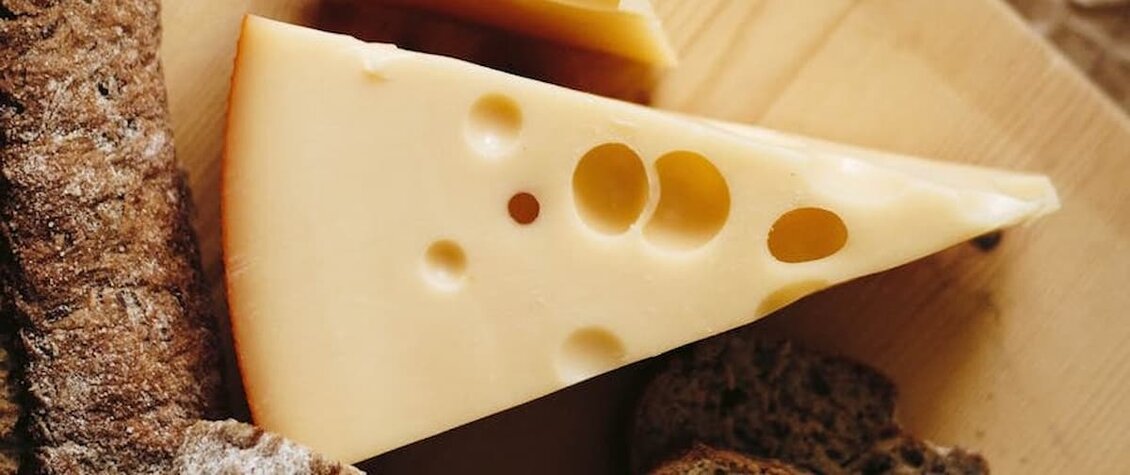Last Updated: 07/05/2025
Can Dogs Eat Cheese?
Does your dog love to indulge in cheese? Find out if this is safe for them in our comprehensive guide.
Author: Dr Samantha Wycherley BVSc
Reading Time: 14 minutes - short read
As dog owners, we often find ourselves wondering about the foods we enjoy and whether or not it would be safe to share with our furry companions.
It can be hard to resist the puppy dog eyes looking up at us as we are enjoying our own food but it's important to make sure we won't be causing any harm before sharing our snacks.
A common food that people want to share with their pooches is cheese - in this article we'll cut through the fluff and explore whether cheese can be a tasty treat or a potential belly ache for our pups. Can dogs really enjoy cheese without any problems?
Benefits of Cheese for Dogs
Cheese can be a nutritious treat for dogs - it has a number of beneficial factors. Cheese has a high protein content, which supports muscle growth and repair and a high calcium content, which promotes strong bones and teeth. It also provides essential vitamins like A, B-12, and D, aiding overall health and immune function.
The other benefit of cheese is its taste! Dogs seem to find cheese just as tasty as we do and therefore cheese can be used as a high reward training tool or as a handy way to hide a tablet or pill.

What Are The Risks Of Feeding Cheese To Dogs?
So while cheese can be given to dogs as a treat - the saying is true - there can be too much of a good thing! Cheese is high in fat which can lead to health conditions like pancreatitis or obesity.
Pancreatitis in dogs is a serious condition in which the pancreas becomes very inflamed and they can become very unwell. Pancreatitis is often triggered by high fat foods.
While pancreatitis is typically associated with a single high fat meal, chronic high fat ingestion can lead to obesity.
Obesity is associated with a number of health issues such as arthritis. Obesity is also associated with a shorter lifespan and can decrease a dog's mobility and energy levels, diminishing their ability to enjoy activities.
Cheese is also high in lactose - lactose is a sugar that occurs naturally in milk and in order to digest this dogs need to have the enzyme Lactase. Puppies are born with the lactase enzyme however as dogs grow many lose the ability to digest milk properly. The inability to effectively digest lactose can lead to symptoms of lactose intolerance like flatulence and diarrhoea - which is no fun for your dog (or for you!)
Some cheeses can also contain ingredients which can be toxic to dogs like garlic or chives so it's important to check the ingredients of any cheeses before offering them to your dog too.
There are also types of cheeses that aren't recommended with certain medications - if your dog is on fluoxetine ( a commonly prescribed anxiety medication) then they cannot be fed aged cheeses due to potential interactions with fluoxetine and Tyramine (a naturally occurring substance in certain foods).
So What Is The Best Type Of Cheese To Feed Your Dog?
If you would like to offer your dog a cheesy treat then there are some options that are better than others. Sticking with low fat options like mozzarella, cottage cheese or soft goats cheese is best. Cottage cheese is also lower in lactose, reducing the likelihood of intestinal upset.
Signs of Teething in Kittens
While not all kittens will be affected by teething in the same way, these are some common signs that are often noticed by pet parents during this period:
- Eating less or chewing more slowly- due to tenderness of the gums
- Excessive chewing, particularly on soft items- in an attempt to relieve discomfort
- Red or swollen gums- gum inflammation can indicate that new teeth are coming in
- Increased drooling
- Bleeding gums- generally only a small amount of bleeding is seen, if any. You may notice blood specks in water or food bowls
- Pawing at the mouth- due to discomfort or in an attempt to dislodge a loose tooth
- Increased irritability or restlessness- unexplained fussiness can also be a sign that teething discomfort is bothering your kitten
How to Help a Teething Kitten
Teething can be a trying time for both kittens and their owners. As your kitten navigates this crucial developmental stage, it's essential to offer appropriate support. Here's how you can help manage your kitten's teething period more effectively.
Be gentle when playing
During teething, let your kitten dictate how much they want to bite, grab and chew on things. Avoid pulling toys out of your kitten's mouth or petting them too much around the face or mouth as these areas can be extra sensitive.
Avoid brushing teeth during teething
While brushing your cat's teeth is a valuable tool in maintaining dental health, and a great habit to get into while your kitten is young, it's advised to hold off on brushing during the teething phase. As well as being uncomfortable for your kitten, it can also increase the chance of your pet forming negative associations and becoming more resistant to the process in future.
Help make eating easier
If your kitty is reluctant to eat, or seems to be struggling to chew, there are a few things you can try:
- If feeding kibble, you can soften this with warm water before giving it to your kitten
- Increase the amount of wet food in the diet during the teething phase. Pate or loaf textures may be easier to eat than kibble or large chunks of wet food
- Instead of hard or chewy treats, stick to liquid or paste treats which are easier to eat